This is name after the troll carts which were developed to pass along the many narrow roads inside the town’s medieval walls.
Illustrations and text about troll carts.
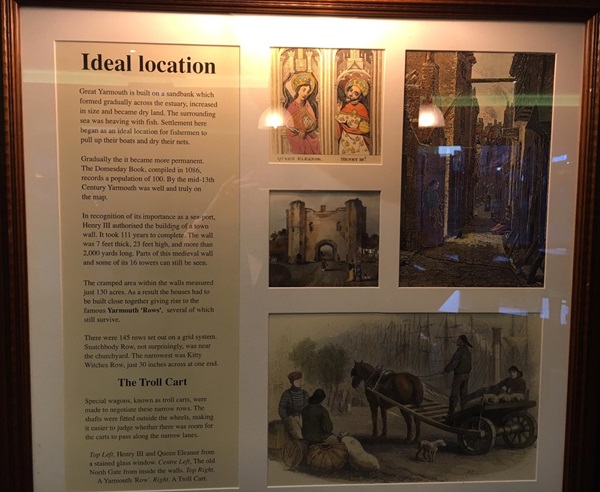
The text reads: Great Yarmouth is built on a sandbank which formed gradually across the estuary, increased in size and became dry land. The surrounding sea was heaving with fish. Settlement here began as an ideal location for fishermen to pull up their boats and dry their nets.
Gradually the it became more permanent. The Domseday Book, compiled in 1086, records a population of 100. By the mid-13th century Yarmouth was well and truly on the map.
In recognition of its importance as a sea-port, Henry III authorised the building of a town wall. It took 111 years to complete. The wall was 7 feet thick, 23 feet high, and more than 2,000 yards long. Parts of this medieval wall and some of its 16 towers can still be seen.
The cramped area within the walls measured just 130 acres. As a result the houses had to be built close together giving rise to the famous Yarmouth ‘Rows’, several of which still survive.
There were 145 rows set out on a grid system. Snatchbody Row, not surprisingly, was near the churchyard. The narrowest was Kitty Witches Row, just 30 inches across at one end.
Special wagons, known as troll carts, were made to negotiate these narrow rows. The shafts were fitted outside the wheels, making it easier to judge whether there was room for the carts to pass along the narrow lanes.
Top left, Henry III and Queen Eleanor from a stained glass window
Centre left, The old North Gate from inside the walls
Top right, A Yarmouth ‘Row’
Right, A Troll Cart
Prints and text about the history of fishing in the area.
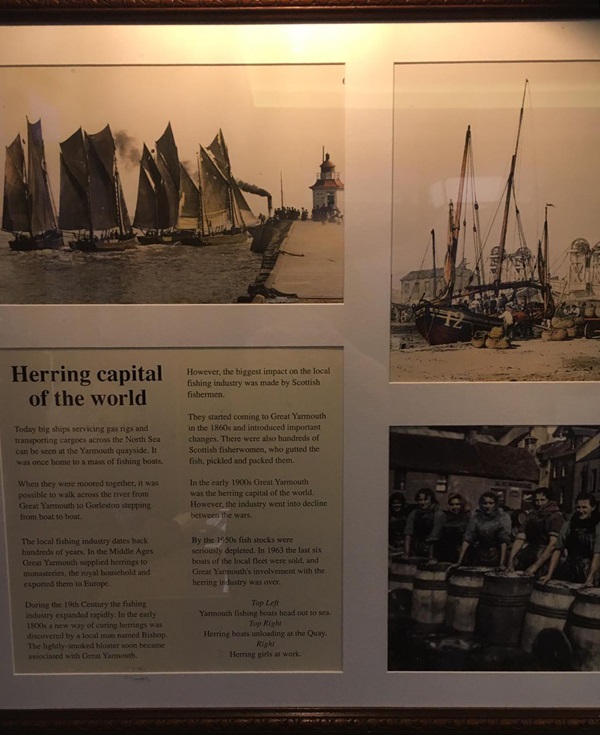
The text reads: Today big ships servicing gas rigs and transporting cargoes across the North Sea can be seen at the Yarmouth quayside. It was once home to a mass of fishing boats.
When they were moored together, it was possible to walk across the river from Great Yarmouth to Gorleston stepping from boat to boat.
The local fishing industry dates back hundreds of years. In the Middle Ages Great Yarmouth supplied herrings to monasteries, the royal household and exported them to Europe.
During the 19th century the fishing industry expanded rapidly. In the early 1800s a new way of curing herrings was discovered by a local man named Bishop. The lightly-smoked bloater soon became associated with Great Yarmouth.
However, the biggest impact on the local fishing industry was made by Scottish fishermen.
They started coming to Great Yarmouth in the 1860s and introduced important changes. There were also hundreds of Scottish fisherwomen, who gutted the fish, pickled and packed them.
In the early 1900s Great Yarmouth was the herring capital of the world. However, the industry went into decline between the wars.
By the 1950s fish stocks were seriously depleted. In 1963 the last six boats of the local fleet were sold, and Great Yarmouth’s involvement with the herring industry was over.
Top left, Yarmouth fishing boats head out to sea
Top right, Herring boats unloading at the Quay
Right, Herring girls at work.
Illustrations and text about witchcraft.
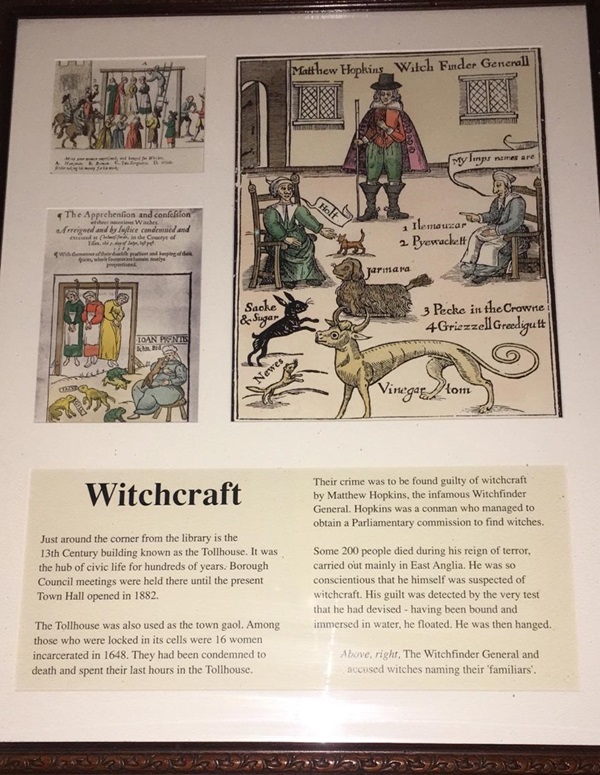
The text reads: Just around the corner from the library is the 13th century building known as the Tollhouse. It was the hub of civic life for hundreds of years. Borough Council meetings were held there until the present Town Hall opened in 1882.
The Tollhouse was also used as the town gaol. Among those who were locked in its cells were 16 women incarcerated in 1648. They had been condemned to death and spent their last hours in the Tollhouse.
Their crime was to be found guilty of witchcraft by Matthew Hopkins, the infamous Witchfinder General. Hopkins was a conman who managed to obtain a Parliamentary commission to find witches.
Some 200 people died during his reign of terror, carried out mainly in East Anglia. He was so conscientious that he himself was suspected of witchcraft. His guilt was detected by the very test that he had devised – having been bound and immersed in water, he floated. He was then hanged.
Above right, The Witchfinder General and accused witches naming their ‘familiars’
A print and text about George Borrow.
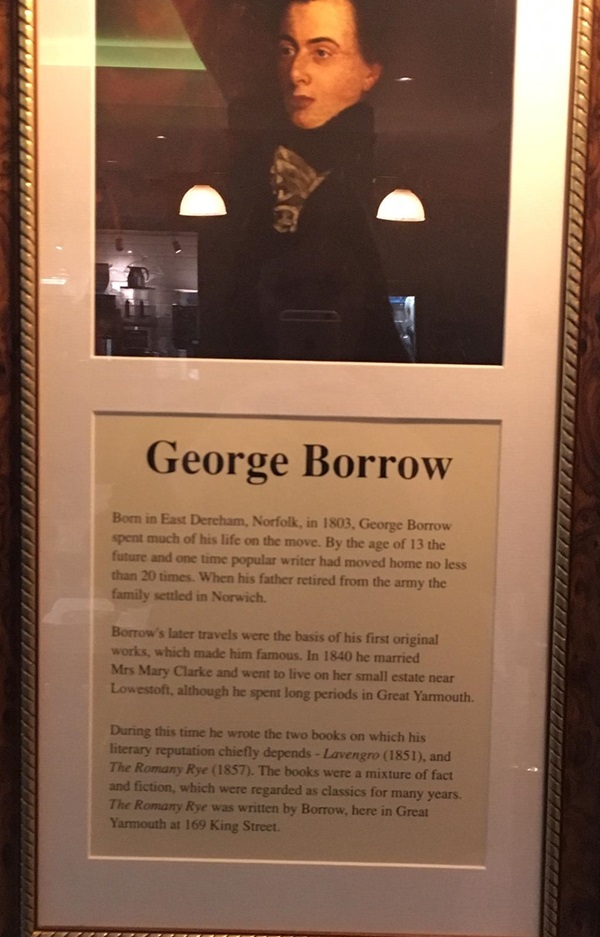
The text reads: Born in East Dereham, Norfolk, in 1803, George Borrow spent much of his life on the move. By the age of 13 the future and one time popular writer had moved home no less than 20 times. When his father retired from the army the family settled in Norwich.
Borrow’s later travels were the basis of his first original works, which made him famous. In 1840 he married Mrs Mary Clarke and went to live on her small estate near Lowestoft, although he spent long periods in Great Yarmouth.
During this time he wrote the two books on which his literary reputation chiefly depends – Lavengro (1851), and The Romany Rye was written by Borrow, here in Great Yarmouth at 169 King Street.
External photograph of the building – main entrance.
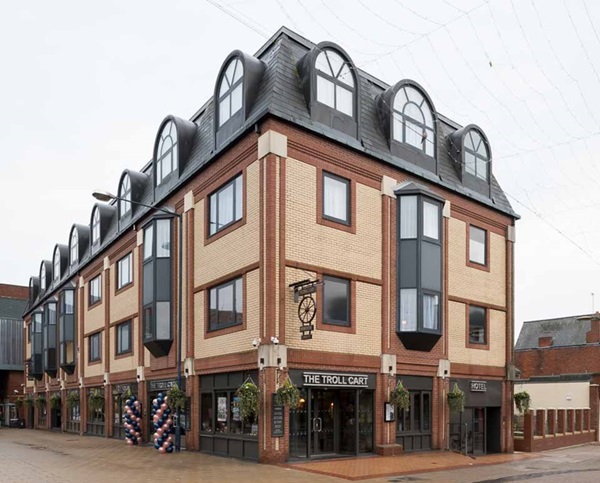
If you have information on the history of this pub, then we’d like you to share it with us. Please e-mail all information to: pubhistories@jdwetherspoon.co.uk